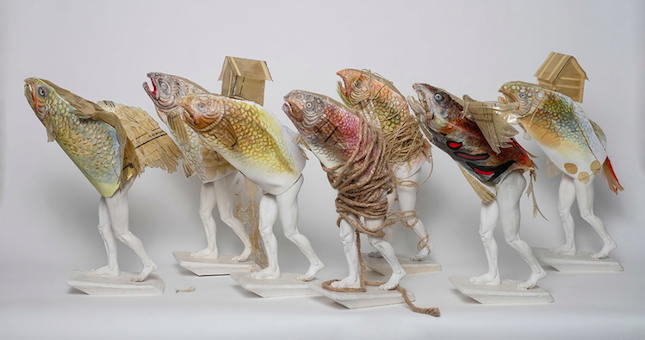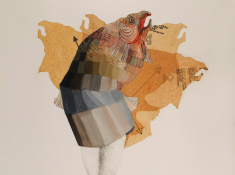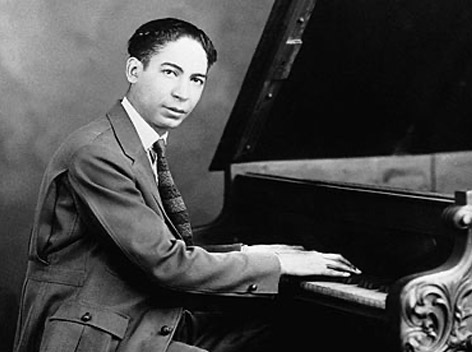
I Belong Here...
An Interview with Pilar Mehlis
Who are you, and what do you do?
My name is Pilar Mehlis. I’m a visual artist and I also teach. I work in mostly painting and drawing, but I’ve been playing with sculpture over the couple of years.
You just had a show at Regent College—can you tell me a little about that?
The show was titled I Belong Here… It consisted of sculptures of 22 hybrid fish/human figures forming a school of fish, along with 14 paintings and mixed-media pieces on the same theme. All of them featured these fish/human figures that I call “Antrofish.”
I modeled the Antrofish figure on the Chinook salmon, because it follows pathways up and down the Pacific that are similar to mine. I thought it would be interesting to explore ideas of migration by juxtaposing human migration and natural migration. Although nothing is too literal. I work usually with magical realism—the idea of the magical becoming present in the moment, in reality. Most of my favourite authors are magical realists, so I’m very keen to use metaphor, to treat ideas in metaphorical ways so they’re more visually interesting.
I understand that the exhibit comes out of your personal experience, that journey up and down the Pacific that you mentioned.
Yes. I’m originally from Bolivia. We emigrated at the end of 1983 to Whitehorse from La Paz. I was 12. It was December. Bolivia is south of the equator: it was sunny and summer. Whitehorse was very much in the dark winter. So that was a bit of a shock.
I think that, because I was so young, I was able to absorb the culture, not seamlessly, but pretty well. There was no resistance on my part to taking on the language and whatever culture was up there, because I wasn’t conscious of what culture really was, I suppose. I knew everything was different, but I wasn’t aware of, you know, trying to preserve things that I was bringing with me as a Bolivian person. So I kind of became a bit of a hybrid that way. When you’re a kid, you’re just a sponge, right? You absorb everything.
In ’87 I went back to Bolivia. I graduated high school there and started university. Then I went back to Whitehorse. Due to chance and circumstance, I ended up in Victoria and finished my studies there at the University of Victoria. I came to Vancouver in 2001, at the end of the summer, and now I travel to Bolivia pretty much every year for a month or so.
How have those places shaped your work?
Oh boy. Bolivia’s my wiring, right? That initial wiring that I think happens in childhood. I always revert back to my roots in my initial reaction to anything, in that initial analysis that you make when you’re confronted with a new idea. I think that shows up in a lot of my artwork.
When I first moved to Victoria, my painting was so melancholic, oh my gosh. I was painting llamas, I was painting cholitas—these images of Bolivian women with their bowler hats—and the Andes: I was painting all of that. [Laughs] That lasted about four years, and then I made a conscious decision to not do that, and to actually seek out who I was. And that’s when I started to read magical realism authors and to begin becoming aware of my own identity. And that started to translate into my artwork.
How did the Antrofish figure come to you? Was it spontaneous, or was it intentionally chosen to represent your experience?
I wasn’t looking for a representation of migration at all: the Antrofish came before that.
I come from a culture of costumes. Costumes are a big deal at certain times of the year in Bolivia: everybody dresses up, especially at Carnival. Throughout the year, there are all of these festivals. They’ll shut down the streets and you’ll get dancers coming down the streets in huge numbers with their banners and musicians. Everything is very coordinated and the costumes are beautifully made. So that language is very normal for me: people dressed up as angels, devils, bears—these massive costumes.
I’d been juxtaposing human and animal for a while, especially in paintings. One day, I was just playing around with my wooden mannequin. I made a really weird-looking fish costume and I plunked it on the mannequin and looked at it for a little while. Then I put it in the back of my mind and in the back of the studio for a couple of years. It was just sitting there and working its way through my mind, from the back burner to the front. One day I picked it up again and I thought—well, how do I make this costume actually look like a costume? And I just started working with it and decided to explore it a little further.
A phrase that came to mind when I saw I Belong Here… was “fish out of water.” How did that idea inform this exhibit?
It wasn’t conscious, but I do live that fish out of water feeling. Everybody does to a certain extent, but it’s funny how people point things out to me, like, “Oh, you’re ESL,” or, “You’re not from here, so it makes sense that you did this a different way,” or whatever. And then you do feel like a fish out of water: suddenly it becomes really clear to you that you don’t quite fit in. And that happens to me in both places—Canada and Bolivia—so I hang somewhere in the middle. I guess that makes the hybrid, right?
It happens a lot with faith, too. I’m a cradle Catholic. In Bolivia, speaking of God or the Virgin is just totally normal language. Everybody does it. But here, [laughs] half the people are like, “who are you talking about?” It’s foreign, almost, and it’s almost taboo. Well, not almost: it is taboo to speak of God here in normal, regular life. And then, again, you feel like a fish out of water. So that feeling is both cultural and faith-based.
As you’ve moved from culture to culture, trying to find your core, how has your faith been relevant?
That is my core. That is absolutely my core. The nice thing about going to Mass is that Mass is the same no matter where you go. The priests are very different in South America and in North America: very different. But there is that common thread. Even if it’s you don’t understand the language, you know how the Mass is structured and you know what everything means, so you can still go deep and search within yourself for that presence of God. You know that you can approach a church, go to Mass, and you’ll find that inner peace.
And that’s a really great consolation for me, especially at times when you’re having difficulties and your family is not around and your friends don’t really understand the cultural moment you may be having. It’s always a great consolation.
Does your faith play into your art explicitly, or is it more of a foundation?
It’s a foundation. I try not to be too literal with anything. That’s a conscious decision sometimes. I like to keep it meaningful but not obvious.
If you were to say that you’re going home, where would that be?
[Laughs] That’s a hard question, because my husband’s here, but my parents and my sister are in La Paz. Here, because of my husband, obviously. But where my heart feels at home is with my husband in Bolivia. Bolivia is where my heart is quiet.
Mind you, sometimes I do long for Vancouver after two weeks or so in Bolivia. I’m never satisfied. [Laughs]
In Christian thought, there is this idea that we’re called to live into and bless this place, but we’re also moving towards an ultimate home. Is that something that resonates for you? Do you find it helpful?
I do find it very helpful, because I think we’re all yearning all the time. Even if you’re in your favourite place with your favourite people and your favourite food, with your favourite everything, you’ll still be yearning. And I think that is true of absolutely everybody, even people who aren’t conscious of it: I think we’re all yearning to go back home. Because we’re put on this planet, but home is with God. On this planet, I’ll never feel satisfied.
How do you carry that tension in your own life?
I always struggle with prayer. But I know that I feel better when I’m more conscious of my relationship with God. I know that it is good for me.
It’s like: I know that salad is good for me, and I know that exercise is good for me, and I know prayer especially is good for me. But those vices, you know, they creep in and they can pull you away. I struggle with that constantly.
There’s a great line—I forget who said it—that “conversion has to be daily.” And it really does. You have to convert every day. Because if you forget to convert one day, then you become more slack the next, in terms of that spiritual health. I find it a really great challenge and struggle.
How have your experiences of home and the loss of home affected your sense of who you are in relation to people around you and in relation to God?
It affected me hugely. Especially in my 20s, when I married the wrong person. That decision was a direct impact of that feeling of being out of place, out of home, out of sorts. But you’re not conscious of that. You feel like you’re free: “Yeah! I’m 25 and I can do whatever I want!”
I felt very independent, but I also longed for home. I missed my parents, I missed everybody, but it’s a really big trip to go to Bolivia and I was in school, and I just couldn’t afford to go home every year. It was impossible. Or, at least, I didn’t prioritize it. And that impacted me for a very long time. It impacted my art. All I was painting was llamas and everything Bolivian and brides running away from their houses: it was really literal. [Laughs] I’m glad the 20s are done.
Now that you’ve started taking regular trips back to Bolivia, has that helped you to integrate your two selves and your two homes?
Well, it never does exactly that, but it definitely helps. I kind of get my injection of Bolivian culture and I get my injection of family: it’s very intense, that’s the only thing. It’s so intense, and then there’s nothing for 11 months.
But I don’t mind it. It’s a good life. My husband is very keen in going back with me and he loves going there with me, so it’s not a struggle. When there’s not much resistance in your personal life, you have a solid platform to really work freely in whatever you do. For me, that’s my studio practice. So I’m not struggling—I mean, I’m always struggling, but it’s not as dire as it used to be. And that gives me the solid foundation, and freedom, to continue with my work for as long as I can.



